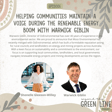
Navigating Contamination: The Power of Informed Preliminary Site Investigations with Howard Waldron
Howard Waldron is the co-founder of Lotsearch, a company that has pioneered the development of environmental information and insights, with a particular focus on potential contamination.
Since the company was founded in 2014, they have been a provider of environmental and planning reports in Australia, helping support environmental consultants when undertaking preliminary site investigations.
More recently, Lotsearch have been engaged to help produce contaminated land registers for a consortium of regional councils across NSW, and by state and federal government agencies to undertake research in identifying potential contamination sources as well as supporting their assessments.
In this episode, Shonelle and Howard discuss the impact contaminated land registers have had on the way local councils manage potential contamination risks. Howard shares how these registers provide councils with vital data to comply with Section 10.7 planning certificates, improving transparency in property transactions and helping prevent environmental and human health impacts.
Howard highlights the importance of streamlining data collection, improving the accuracy of site investigations, and reducing the risk of contamination being missed.
He also shares insights into Lotsearch’s evolution over the past decade and explores how AI and machine learning are enhancing the accuracy of contamination data -- and what the future holds for environmental data in local government decision-making.
To read the opinion piece written by Norton Rose Fulbright, ‘Real estate lawyers’ duties and responsibilities in relation to contaminated land’, click here.
-----
Are you a local NSW council member looking for more resources like this?
You are invited to join the Local Government NSW Contaminated Land Network!
Local Government NSW (LGNSW) hosts a free, online network for council staff on the topic of contaminated land. The network includes an online forum for collaboration, information sharing and announcements about contaminated land regulation, guidance and training opportunities. Monthly meetings are held on themes that were set by the network participants, with presentations from regulators, technical experts, and case studies by councils.
Since the contaminated land network commenced in December 2023, more than 50% of NSW councils have joined, with over 200 participants. Feedback shows that councils are benefitting greatly from the network meetings and discussion on the platform, and we are pleased to invite you to join us.
To join the network, please use this link: https://lgsa.wufoo.com/forms/w1rf0os910rxyl6/
The Contaminated Land Network forms part of a project called “Councils Managing Contaminated Land Together” funded by the NSW Environment Protection Authority (NSW EPA) to support capacity building and informed decision-making by those involved in contaminated land management in councils. The project also comprises a webpage with up-to-date information and links to resources, which can be accessed here.
We hope to see you on the network soon!



















